Welcome to the DJI Mavic User Manual, your comprehensive guide to unlocking the full potential of your drone. This manual covers key features, safety guidelines, and operational tips to ensure a safe and enjoyable flying experience. Whether you’re a beginner or an advanced user, this manual will help you master your DJI Mavic drone’s capabilities, from camera settings to flight modes, ensuring optimal performance and creativity.
1.1 Key Features of the DJI Mavic Series
The DJI Mavic series is renowned for its cutting-edge technology and versatility. Key features include a high-resolution 4K camera with a 3-axis gimbal for stable footage, advanced obstacle avoidance systems, and extended flight ranges. The Mavic 3 Pro boasts a triple-camera setup with a Hasselblad main sensor, while the Mavic 4 Pro introduces a rotating triple-camera module. These drones also feature intelligent flight modes like ActiveTrack and Point of Interest, enabling dynamic and precise aerial photography. With ultra-long battery life and O4 video transmission, the Mavic series delivers unparalleled performance for both recreational and professional use, making it a favorite among drone enthusiasts worldwide.
1.2 Importance of Reading the User Manual
Reading the DJI Mavic user manual is essential for safe and effective operation of your drone. It provides critical safety guidelines, legal requirements, and operational best practices to ensure responsible flying. The manual details how to navigate no-fly zones, perform pre-flight checks, and understand local regulations. It also helps users troubleshoot common issues and optimize drone performance. By following the manual, you can maximize your drone’s capabilities while minimizing risks. Regular updates and firmware instructions are also covered, ensuring your device stays up-to-date. Familiarizing yourself with the manual is key to enhancing your flying experience and maintaining compliance with aviation laws.

Safety Guidelines and Precautions
Always follow safety guidelines to ensure responsible drone operation. Understand local regulations, no-fly zones, and pre-flight checks. Use the DJI Fly app for real-time safety data and alerts.
2.1 General Safety Tips for Drone Operation
Always ensure a safe environment for drone operation. Avoid flying near obstacles, people, or animals. Maintain a clear line of sight and check weather conditions before flight. Never fly in strong winds, rain, or extreme temperatures. Keep the drone away from power lines, airports, and sensitive areas. Ensure the battery is fully charged and avoid overloading the drone. Regularly inspect propellers and components for damage. Follow local regulations and respect privacy rights. Update firmware and software to ensure optimal performance. Consult the user manual for specific safety recommendations and best practices to minimize risks during flight operations.
2.2 Understanding No-Fly Zones and Regulations
DJI Mavic drones are equipped with GEO fencing systems to prevent flights in restricted areas like airports, national parks, or sensitive locations. These no-fly zones are implemented for safety and regulatory compliance. Always check local aviation authority websites for specific rules and guidelines. Use the DJI Fly or GO apps to view real-time no-fly zone data. Ensure compliance with all regulations, including altitude limits and airspace restrictions. Understanding these zones is crucial to avoid legal issues and ensure safe, responsible drone operation. Familiarize yourself with regional laws and respect restricted areas to maintain smooth and lawful flight experiences with your DJI Mavic drone.
2.3 Pre-Flight and Post-Flight Safety Checks
Before each flight, ensure all components are secure, including propellers, gimbal, and battery. Check battery levels and charge if necessary. Verify firmware is up-to-date and calibrate the compass. Use the DJI Fly app for system diagnostics and ensure no software issues exist. After landing, power off the drone, detach propellers, and store the device in a dry, cool place. Regularly inspect for damage and clean the camera lens. Post-flight checks help maintain performance and longevity. Always refer to the user manual for detailed procedures to ensure safe and efficient operation of your DJI Mavic drone;
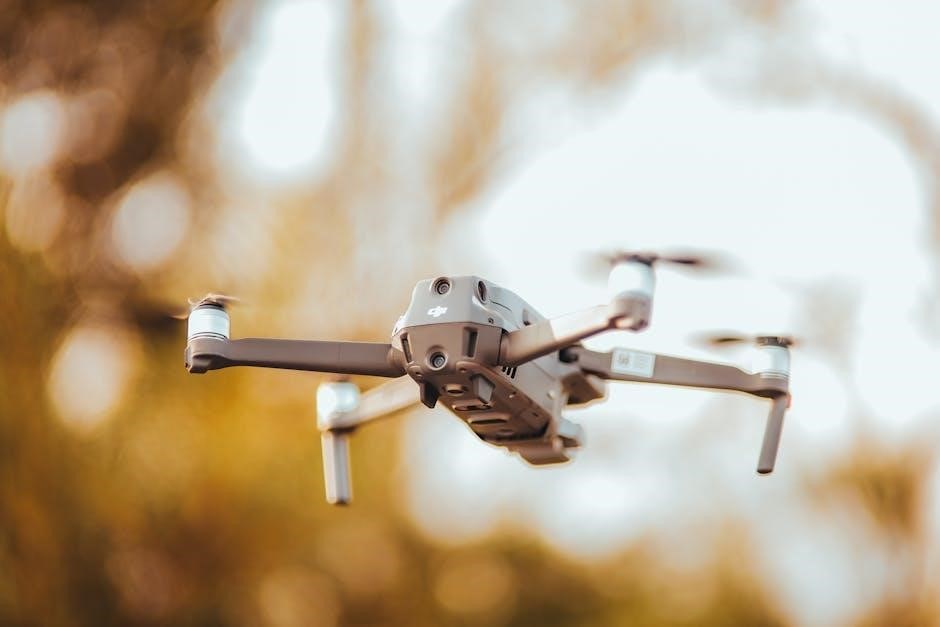
Unboxing and Contents
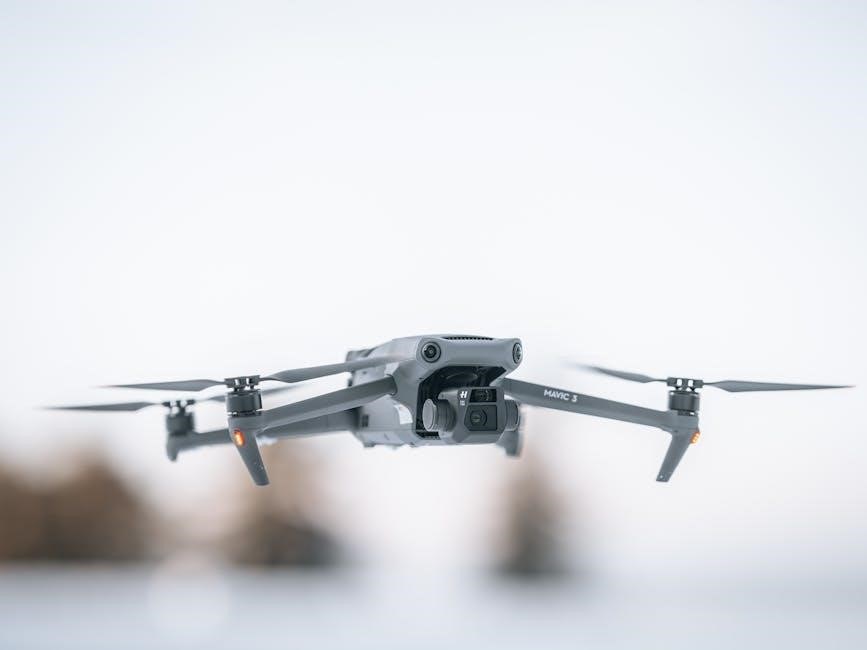
Welcome to the unboxing section of your DJI Mavic User Manual. Inside the box, you’ll find the aircraft, remote controller, batteries, and essential accessories for a seamless flight experience.
3.1 What’s Included in the Box
Upon unboxing your DJI Mavic drone, you’ll find the aircraft, remote controller, intelligent flight battery, and essential accessories. The box typically includes:
- Aircraft: The Mavic drone with a 3-axis gimbal-stabilized camera.
- Remote Controller: For navigating and controlling the drone’s functions.
- Batteries: One or more high-capacity flight batteries.
- Propellers: A set of low-noise propellers for optimal flight performance.
- Cables: USB and charging cables for the remote and batteries.
- Manuals: A user manual, quick start guide, and safety guidelines.
- Other Accessories: Gimbal covers, landing pads, and optional extras.
Contents may vary depending on the Mavic model and purchase options.
3.2 Accessories and Optional Equipment
To enhance your DJI Mavic experience, consider these accessories:
- Propeller Cage: Protects the propellers during collisions or indoor flights.
- ND Filters: Reduces lens glare and enhances video quality in bright light.
- Landing Pad: Provides a stable, dust-free surface for takeoff and landing.
- Extra Batteries: Extend flight time with additional high-capacity batteries.
- Charging Hub: Charges multiple batteries simultaneously for convenience.
- Carrying Case: Protects the drone and accessories during transport.
- Third-Party Mounts: For attaching external devices like lights or cameras.
Optional equipment can be purchased separately to tailor your setup to specific needs.
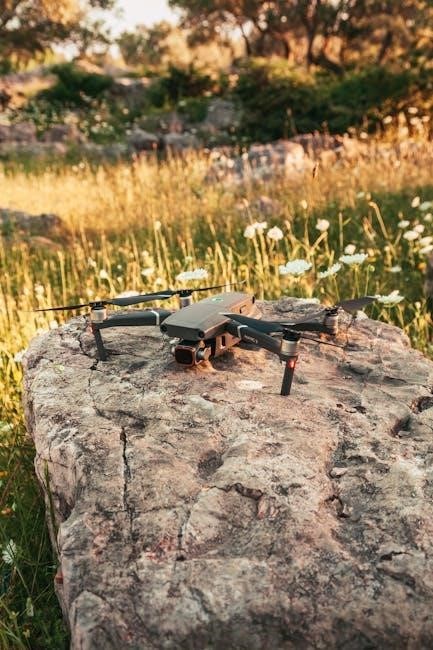
First Flight Preparation
Prepare for your first flight by registering your drone, charging the battery, and attaching propellers. Use the DJI Fly app to complete setup and ensure all systems are ready.
4.1 Registering Your Drone
Registering your DJI Mavic drone is a crucial step before your first flight. Depending on your region, registration may be required by local aviation authorities. Use the DJI Fly app to complete the registration process, which typically involves creating a DJI account, linking your drone to the account, and agreeing to safety guidelines. Ensure your drone is connected to the internet during registration. This step ensures compliance with regulations and unlocks full functionality. Refer to the app or manual for specific instructions tailored to your location and drone model.
4.2 Charging the Battery and Remote Controller
Charging your DJI Mavic drone and remote controller is essential for a smooth first flight. Use the original DJI charger and cables to ensure safety and compatibility. Plug the charger into a power source and connect the battery using the provided USB-C or other compatible ports. The battery typically takes 1-2 hours to fully charge, while the remote controller may take slightly less time. Avoid overcharging, as this can reduce battery lifespan. Ensure both devices are fully charged before your first flight for optimal performance. Always use DJI-approved accessories to prevent damage or safety issues.
4.3 Attaching and Detaching Propellers
Attaching and detaching propellers on your DJI Mavic drone is a straightforward process. Ensure the drone is powered off before handling the propellers. To attach, align the propeller with the motor shaft, ensuring the clockwise and counterclockwise symbols match their respective motors. Gently push and twist until it clicks securely. For removal, pull down on the propeller while twisting in the opposite direction of the symbol. Handle propellers carefully to avoid damage. Always use the low-noise propellers provided by DJI for optimal performance and noise reduction. Properly secure or store propellers when not in use to prevent loss or damage.
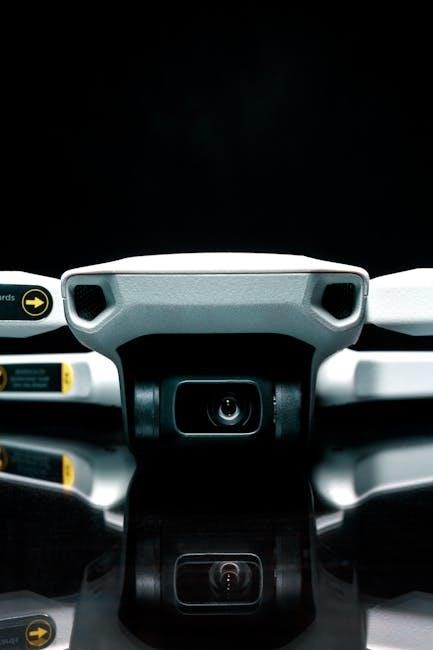
Remote Controller and DJI Fly App
The remote controller and DJI Fly app are essential for controlling your Mavic drone. The app provides real-time flight data, customizable settings, and enhances your flying experience with intelligent features.
5.1 Remote Controller Components and Functions
The DJI Mavic remote controller features joysticks for flight control, C1/C2 buttons for customizable functions, and a Gimbal dial for camera tilt. The integrated screen displays real-time telemetry data, while the antennas ensure stable signal transmission. Additional buttons allow quick access to camera settings, flight modes, and Return-to-Home functions. The controller’s ergonomic design enhances comfort during long flights, and its adjustable phone mount supports various device sizes. Understanding each component’s function is crucial for mastering drone operation and capturing stunning footage efficiently.
5;2 Downloading and Installing the DJI Fly App
To fully utilize your DJI Mavic drone, download and install the DJI Fly app. Available for both iOS and Android, the app is essential for accessing advanced flight features and camera settings. Start by scanning the QR code provided in the user manual or visiting the official DJI website. Once downloaded, follow the on-screen instructions to install the app and ensure your device meets the minimum system requirements. After installation, log in or create a DJI account to activate the app. Regular updates are released to enhance functionality, so always check for the latest version to maintain optimal performance and compatibility with your drone.
5.3 Customizing Remote Controller Settings
Customizing your DJI Mavic remote controller settings enhances your flying experience. Open the DJI Fly app, navigate to the settings menu, and adjust control stick sensitivity to suit your preference. You can also modify button assignments for functions like camera settings or flight modes. Additionally, customize the control layout to optimize comfort and efficiency. Save your settings after adjustments to ensure they are applied during flights. Regularly review and update these settings as needed to maintain optimal performance and adapt to new features or firmware updates. Personalizing your remote controller ensures a tailored and intuitive flying experience.

Camera and Gimbal Setup
The DJI Mavic’s 3-axis gimbal ensures smooth and stable footage. Adjust camera settings, choose modes like Photo, Video, or Hyperlapse, and ensure proper gimbal balance for optimal performance.
6.1 Understanding the 3-Axis Gimbal Stabilization
The DJI Mavic series features a 3-axis gimbal, providing exceptional camera stabilization. This system counteracts unwanted movements, ensuring smooth footage even during high-speed flights or strong winds. The gimbal stabilizes the camera on three axes: roll, pitch, and yaw. This advanced technology minimizes vibrations and ensures sharp, clear images and videos. Proper balancing of the gimbal before flight is essential for optimal performance. Regularly check and adjust the gimbal settings to maintain stability, especially when using different camera modes or in varying environmental conditions. This feature is crucial for professional-grade photography and videography with the Mavic drone.
6.2 Camera Settings and Modes
The DJI Mavic camera offers versatile settings and modes to capture stunning photos and videos. Users can switch between photo and video modes, adjusting exposure, ISO, and white balance for optimal results. The camera supports formats like JPEG and RAW for photography, while video modes include 4K resolution at 60fps. Intelligent modes such as Hyperlapse, Panorama, and FocusTrack enhance creativity. Additionally, the DJI Fly app allows real-time preview and adjustments, ensuring precise control over your shots. These features make the Mavic an ideal choice for both casual and professional photographers and videographers, delivering high-quality content in various lighting conditions and scenarios.
6.3 Adjusting Gimbal Settings for Optimal Performance
To ensure smooth and stable footage, adjust your DJI Mavic’s gimbal settings according to your shooting needs. Access gimbal settings via the DJI Fly app, where you can fine-tune roll, pitch, and yaw. Calibration is essential for maintaining balance and preventing drift. Use the gimbal dial to manually adjust the camera angle for dynamic shots. Enable features like Gimbal Lock to stabilize the camera during high-speed flights. Regularly check and adjust the gimbal settings to adapt to different environments and ensure optimal performance. Proper configuration enhances image quality and reduces vibrations, delivering professional-grade results in various flight scenarios.
Flight Modes and Intelligent Features
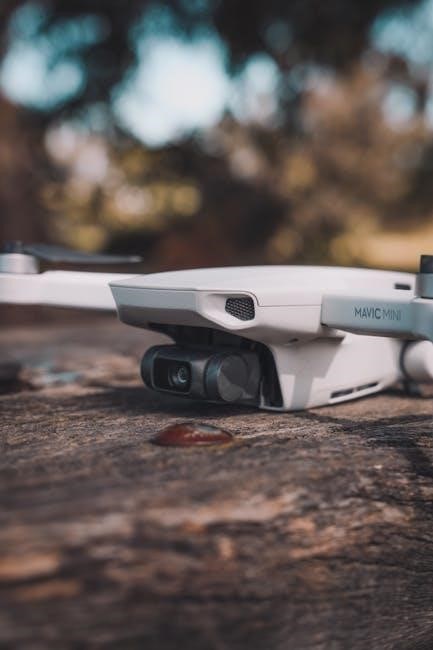
Explore advanced flight modes like Sport, Tripod, and Cine for tailored flying experiences. Utilize intelligent features such as ActiveTrack, POI, and obstacle avoidance for seamless and creative drone operations.
7.1 Sport Mode, Tripod Mode, and Cine Mode
Discover the versatility of DJI Mavic’s flight modes. Sport Mode delivers agile and high-speed performance, ideal for dynamic shots and racing. Tripod Mode prioritizes precision and stability, perfect for indoor flights or tight spaces. Cine Mode offers smooth, cinematic movements, enhancing your video production. Each mode tailors the drone’s behavior to your creative or operational needs, ensuring optimal results in various scenarios. Experiment with these modes to unlock new possibilities for your flights and captures.
7.2 ActiveTrack and Point of Interest (POI) Modes
Enhance your aerial photography with ActiveTrack and Point of Interest (POI) modes; ActiveTrack enables the drone to autonomously follow a subject, maintaining focus while you concentrate on composition. POI mode allows the drone to circle around a selected point of interest, capturing stunning 360-degree footage. Both modes are perfect for dynamic shots and complex scenes, simplifying advanced cinematography. Use ActiveTrack for tracking moving subjects and POI for highlighting landmarks or objects, creating professional-grade content effortlessly. These intelligent features make capturing unique perspectives easier and more enjoyable than ever.
7.3 Obstacle Avoidance and Return to Home (RTH) Features
The DJI Mavic series is equipped with advanced obstacle avoidance systems, including multi-directional vision systems and infrared sensing, ensuring safe navigation in complex environments. These features automatically detect and avoid obstacles during flight, providing an additional layer of safety. The Return to Home (RTH) function is activated when the battery is low or the drone loses connection, guiding it back to its starting point. RTH also avoids obstacles during its return journey, ensuring a safe landing. These features enhance flight safety and reliability, allowing pilots to focus on capturing stunning footage without worrying about collisions or losing their drone.
Updating Firmware and Software
Regularly update your DJI Mavic’s firmware and software to ensure optimal performance, security, and access to new features. Use the DJI Fly app to check for updates, and follow on-screen instructions to update the drone and remote controller. This process is crucial for maintaining functionality and compatibility with accessories.
8.1 Checking for Firmware Updates
To ensure your DJI Mavic operates at its best, regularly check for firmware updates. Connect your drone to the remote controller, power it on, and open the DJI Fly app. Navigate to the “Control” or “Settings” section, where you’ll find an option to check for updates. If an update is available, follow the on-screen instructions to download and install it. Always ensure a stable internet connection and avoid turning off the drone during the update process. Once complete, restart your device and confirm the update in the app. This ensures you have the latest features and security patches.
8.2 Updating the Remote Controller and Drone Firmware
To update your DJI Mavic’s remote controller and drone firmware, start by connecting the remote to your drone and ensuring both are powered on. Open the DJI Fly app, navigate to the “Control” or “Settings” section, and select “Firmware Update.” If an update is available, download and install it by following the on-screen instructions. Ensure the drone and remote remain powered on and connected throughout the process. Once the update is complete, restart both devices and verify the update in the app. Regular firmware updates enhance performance, add new features, and improve compatibility, ensuring optimal flight experience.
8.3 Troubleshooting Firmware Update Issues
If a firmware update fails or is interrupted, restart the drone and remote controller, then retry the update. Ensure a stable internet connection and sufficient battery life. If issues persist, download the latest firmware from the DJI website and manually install it using DJI Assistant 2. Resetting the drone or remote controller to factory settings may also resolve the problem. For unresolved issues, consult the user manual or contact DJI support for assistance. Regular updates are crucial for optimal performance, so troubleshooting promptly ensures uninterrupted operation and access to the latest features.

Maintenance and Troubleshooting
Regularly clean your DJI Mavic and inspect components for damage. Update firmware promptly and reset devices if issues arise. Consult the manual or DJI support for assistance.
9.1 Cleaning and Maintaining the Drone
Regular maintenance is essential to ensure your DJI Mavic operates at peak performance. Clean the drone with a soft cloth, avoiding harsh chemicals. Inspect propellers for damage and replace if necessary. Use compressed air to remove dust from vents and sensors. Update firmware regularly to maintain functionality. Store the drone in a dry, cool place to prevent battery degradation. Proper care extends the lifespan and ensures reliable flight operations. Always follow the manual’s guidelines for cleaning and maintenance to keep your DJI Mavic in optimal condition.
9.2 Common Issues and Solutions
Common issues with the DJI Mavic often relate to firmware, propellers, or compass calibration. If the drone experiences firmware issues, update via the DJI Fly app. Propeller damage can cause instability; inspect and replace if necessary. Compass errors may occur; recalibrate by following in-app instructions. For connection problems, restart the drone and remote controller. Ensure all software is up-to-date. If issues persist, refer to the troubleshooting section or contact DJI support. Regular maintenance and updates help prevent these issues, ensuring smooth and safe flight operations. Always consult the user manual for detailed solutions and guidelines.
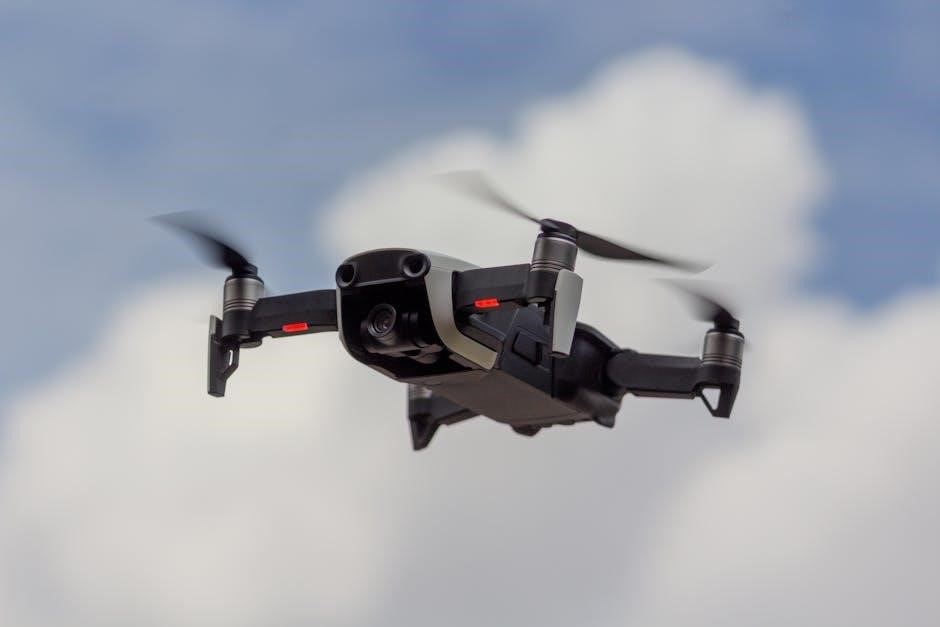
9.3 Resetting the Drone and Remote Controller
To reset the DJI Mavic drone and remote controller, locate the reset button on the drone, typically near the gimbal or battery compartment. Press and hold it for 10 seconds until the lights flash, indicating a factory reset. For the remote controller, find the reset button, often under the sticks or on the back, and press it for 10 seconds. After resetting, restart both devices and re-pair them using the DJI Fly app. Note that custom settings will be erased, so reconfigure them as needed. If issues persist, consult the user manual or contact DJI support for assistance. Ensure proper pairing for optimal performance.
Accessories and Compatible Devices
Explore DJI’s array of official accessories, including propellers, batteries, and carrying cases, designed to enhance your Mavic experience. Third-party devices, like filters and adapters, are also supported, ensuring compatibility and performance. Visit the DJI Store for authentic products and expand your drone’s functionality with trusted accessories.
10.1 Overview of DJI Accessories
DJI offers a wide range of accessories designed to enhance your Mavic drone’s functionality and user experience. From high-quality propellers and intelligent batteries to convenient chargers and carrying cases, these accessories ensure optimal performance and portability. The DJI Store provides authentic products tailored for your Mavic model, guaranteeing compatibility and reliability. Accessories like filters, adapters, and extension kits can also be explored to customize your drone setup. Whether you’re a professional or hobbyist, DJI’s ecosystem of accessories empowers you to capture stunning footage and explore new creative possibilities with your Mavic drone.
10.2 Using Third-Party Accessories
While DJI offers a variety of official accessories, third-party options can also enhance your Mavic experience. Ensure any third-party accessories are compatible with your Mavic model and meet DJI’s safety standards. Research reputable brands and read reviews to avoid potential issues. Third-party accessories may offer unique features or cost savings but always test them thoroughly before flight. Compatibility and safety should never be compromised. Using non-DJI approved products may void your warranty, so proceed with caution and verify specifications carefully to maintain optimal drone performance and reliability.
11.1 Where to Find More Information
For additional details about your DJI Mavic drone, visit the official DJI website at www.dji.com. Explore the Download Center for user manuals, firmware updates, and tutorial videos. The DJI Support page offers troubleshooting guides and FAQs. Join the DJI Community Forums to connect with other pilots, share tips, and stay updated on the latest features. Download the DJI Fly or DJI GO apps for real-time assistance and flight planning. Follow DJI’s official social media channels for product announcements and updates. These resources ensure you stay informed and make the most of your DJI Mavic experience.
11.2 Official DJI Support and Community Forums
For personalized assistance, visit the official DJI Support page, offering detailed FAQs, troubleshooting guides, and repair services. Engage with the DJI Community Forums, where pilots share experiences, tips, and solutions. The forums are a valuable resource for learning from experts and enthusiasts. Additionally, the DJI Fly and DJI GO apps provide in-app support and virtual flight tutorials. For direct help, contact DJI Support via email or live chat. These official channels ensure comprehensive assistance, enhancing your DJI Mavic experience and resolving any issues promptly.

